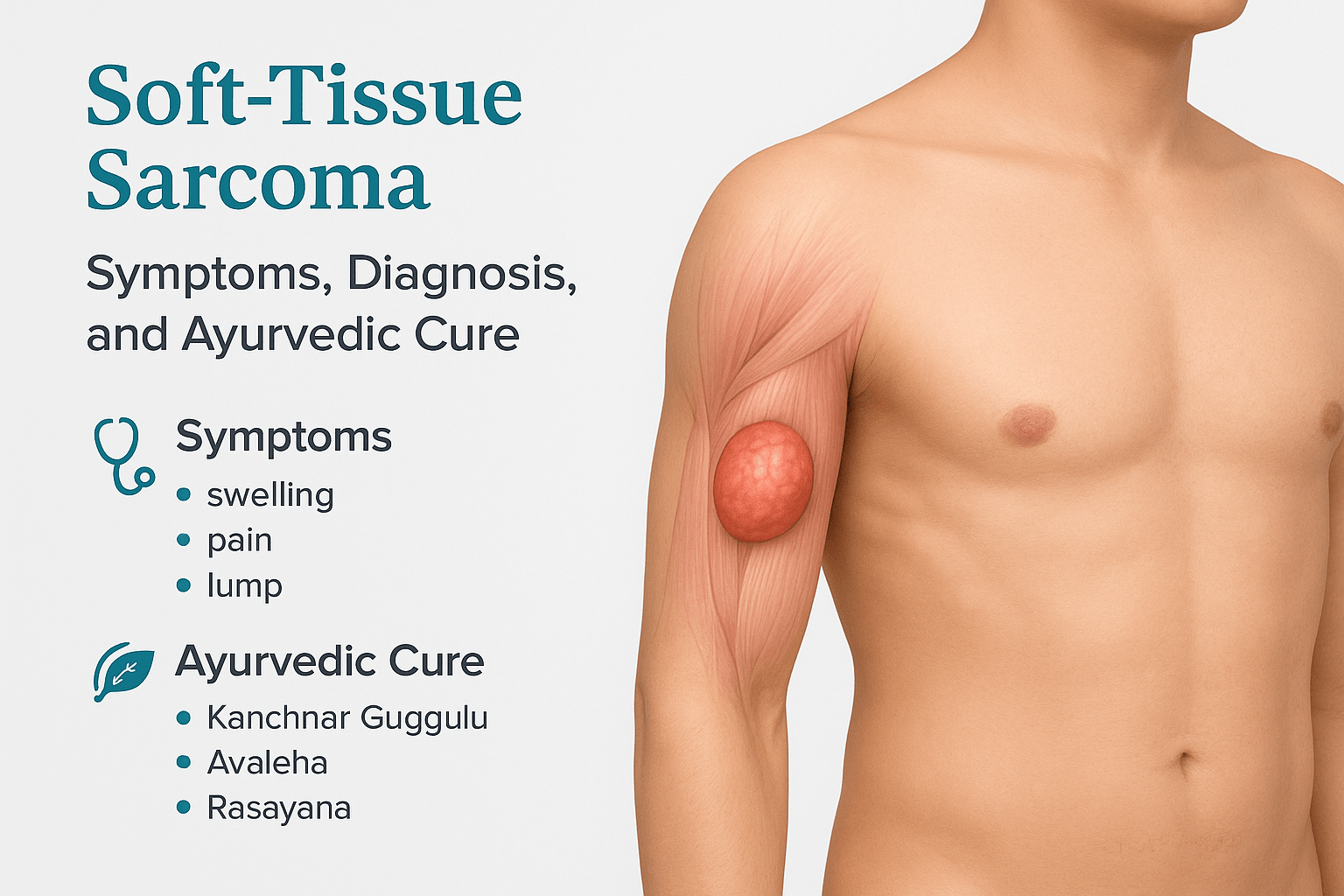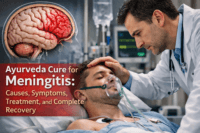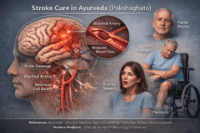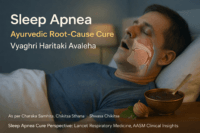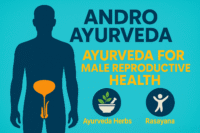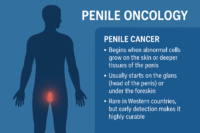- Ayurvedic Interpretation (Granthi and Arbuda)
- Integrative Understanding
- Types of Soft-Tissue Sarcoma
- Etiology and Risk Factors
- Pathophysiology
- Clinical Presentation (Symptoms)
- Ayurvedic Perspective on Lakshana (Signs and Symptoms)
- Diagnostic Approaches
- Staging and Grading
- Management in Modern Medicine
- Ayurvedic Cure with Kanchnar Avaleha
- Disclaimer
- FAQs
- References
Soft-tissue sarcomas are a heterogeneous group of malignant tumors that originate from mesenchymal tissues including fat, muscle, fibrous connective tissue, nerves, and vascular structures. Unlike epithelial cancers, these tumors arise from supportive and structural tissues of the body. They are typically aggressive and have the potential for both local invasion and distant metastasis, particularly to the lungs [1].
Epidemiology and incidence worldwide:
Although rare, STS contributes significantly to global cancer burden. They represent about 1% of all adult malignancies but nearly 15% of pediatric cancers. In the United States, approximately 27,000 new cases are diagnosed each year, while the global incidence varies between 1.8 and 5 per 100,000 annually [2]. Their rarity, diverse subtypes, and often silent early presentation make them diagnostically challenging, frequently resulting in delayed detection and poor prognosis [3].
Distinction from bone sarcomas:
Sarcomas can broadly be classified into soft-tissue sarcomas and bone sarcomas. While bone sarcomas such as osteosarcoma and Ewing’s sarcoma arise within skeletal tissue, soft-tissue sarcomas develop in non-osseous connective tissues. This differentiation is crucial because it influences clinical approach, staging, and survival outcomes [4].
Ayurvedic Interpretation (Granthi and Arbuda)
The ancient seers described tumor-like conditions under two major categories: Granthi (benign swellings) and Arbuda (malignant tumors).
Granthi (benign swelling):
Sushruta explains:
“वातपित्तकफैः सर्वैः क्वचित् क्वचिदन्यतः ।
ग्रन्थयो जायन्ते देहे मांसशोणितसंश्रयाः ॥”
(Sushruta Samhita, Nidana Sthana 11/12)
Translation: Granthi (glandular swellings or benign tumors) arise due to vitiation of Vata, Pitta, and Kapha, either collectively or individually, and localize in the tissues of muscle (Mamsa) and blood (Rakta) [5].
Arbuda (malignant tumor):
Sushruta provides a clear description of Arbuda:
“वातपित्तकफैर्युक्ते मांसशोणितमेव च ।
स्थूलोऽचलोऽनुपक्लिष्टो न चोपशममृच्छति ॥”
(Sushruta Samhita, Nidana Sthana 11/12)
Translation: When vitiated Vata, Pitta, Kapha along with Rakta and Mamsa Dhatus combine, they give rise to a large, immovable, deep-seated growth called Arbuda. Such growths do not subside naturally and are considered malignant in character [6].
Charaka’s Perspective:
Charaka highlights systemic deterioration caused by Arbuda due to impairment of immunity (Ojas):
“अर्बुदं नाम यत्तुस्थं न चोपशममृच्छति ।
तदोषदुष्टं गाढं च, बलं चापहरत्यपि ॥”
(Charaka Samhita, Chikitsa Sthana – Rasayana Adhyaya)
Translation: Arbuda is a deep-rooted, immovable swelling that does not resolve on its own. It arises from severe vitiation of Doshas, causes profound tissue damage, and gradually diminishes the strength and immunity (Ojas) of the patient [7].
Integrative Understanding
- Granthi can be correlated with benign soft-tissue tumors such as lipomas or fibromas [8].
- Arbuda parallels the description of malignant soft-tissue sarcomas, given its invasive, non-resolving, and debilitating nature [9].
Thus, Ayurveda not only recognized tumor pathology but also classified it in a way remarkably consistent with modern oncology. Furthermore, it emphasized holistic management through Shodhana (purification), Shamana (palliative therapies), Rasayana (rejuvenation), and Avaleha preparations to restore systemic balance and strengthen immunity against progression [10].
Types of Soft-Tissue Sarcoma

Soft-tissue sarcomas (STS) represent a highly diverse group of malignant tumors that arise from mesenchymal tissues. More than 70 histological subtypes have been identified, each reflecting its tissue of origin, biological behavior, and clinical course. While these tumors share common features such as their potential to grow silently and spread aggressively, they differ in prognosis and response to therapy [11]. Understanding the major subtypes is essential for accurate diagnosis and effective treatment planning.
Liposarcoma
Liposarcoma is one of the most frequently encountered soft-tissue sarcomas, typically arising in deep soft tissues such as the thigh or retroperitoneum. It originates from fat cells, but its behavior varies widely depending on the subtype. Well-differentiated liposarcoma tends to grow slowly and is locally aggressive, whereas dedifferentiated or pleomorphic variants are far more malignant, with high rates of recurrence and metastasis. Clinically, patients often present with a painless, enlarging mass that may compress nearby organs if retroperitoneal in location [12].
Leiomyosarcoma
Leiomyosarcoma arises from smooth muscle tissue and accounts for about 10–20% of adult soft-tissue sarcomas. Commonly affected sites include the uterus, large blood vessels, and gastrointestinal tract. These tumors often display aggressive growth patterns, with a tendency to metastasize to the liver and lungs. They are usually resistant to conventional chemotherapy, making complete surgical excision the cornerstone of therapy. Hormonal factors may influence uterine leiomyosarcoma, adding another layer of complexity to management [13].
Synovial Sarcoma
Despite its name, synovial sarcoma does not develop from synovial tissue but is closely associated with a unique chromosomal translocation, t(X;18). It predominantly affects young adults and typically arises in the extremities, particularly around joints. Clinically, it may mimic benign joint or tendon lesions, leading to delays in diagnosis. Synovial sarcoma is highly aggressive, with a significant risk of lung metastasis. Multimodal treatment, including surgery, chemotherapy, and radiotherapy, is often required [14].
Angiosarcoma
Angiosarcoma is a rare but particularly aggressive malignancy arising from endothelial cells of blood vessels or lymphatics. It may occur in the skin, breast, liver, spleen, or deep tissues. Chronic lymphedema, prior radiation therapy, and environmental carcinogens such as vinyl chloride are established risk factors. Clinically, angiosarcoma may present as a bruised or ulcerated area that enlarges rapidly. Prognosis is poor due to its rapid spread and resistance to therapy [15].
Fibrosarcoma
Fibrosarcoma originates from fibroblasts and primarily affects the extremities and trunk. While adult fibrosarcoma is rare and aggressive, infantile fibrosarcoma represents a distinct subtype with a more favorable prognosis. Patients often present with a firm, painless mass that may cause functional impairment depending on its size and location. Surgical removal remains the primary treatment, though high recurrence rates pose challenges [16].
Rhabdomyosarcoma
Rhabdomyosarcoma is the most common soft-tissue sarcoma in children and adolescents, arising from primitive skeletal muscle cells. The three major subtypes—embryonal, alveolar, and pleomorphic—vary in prognosis and clinical features. Embryonal rhabdomyosarcoma often appears in the head and neck or genitourinary tract, while alveolar rhabdomyosarcoma, typically found in the extremities, carries a worse prognosis. Treatment involves intensive multimodal therapy, including surgery, chemotherapy, and radiotherapy [17].
Malignant Peripheral Nerve Sheath Tumor (MPNST)
MPNST arises from Schwann cells or peripheral nerves and is strongly associated with neurofibromatosis type 1 (NF1). It usually affects young adults and presents as a rapidly enlarging painful mass. These tumors are highly malignant, with recurrence and metastasis being common despite aggressive surgical and adjuvant therapies. The link with NF1 highlights the genetic predisposition underlying this subtype [18].
Rare Variants
Several other rare sarcoma types exist, including clear cell sarcoma, epithelioid sarcoma, desmoplastic small round cell tumor, and alveolar soft part sarcoma. These variants often mimic other malignancies, both clinically and histologically, complicating diagnosis. Their rarity underscores the importance of specialized sarcoma centers and molecular pathology for accurate classification and treatment planning [19].
Etiology and Risk Factors
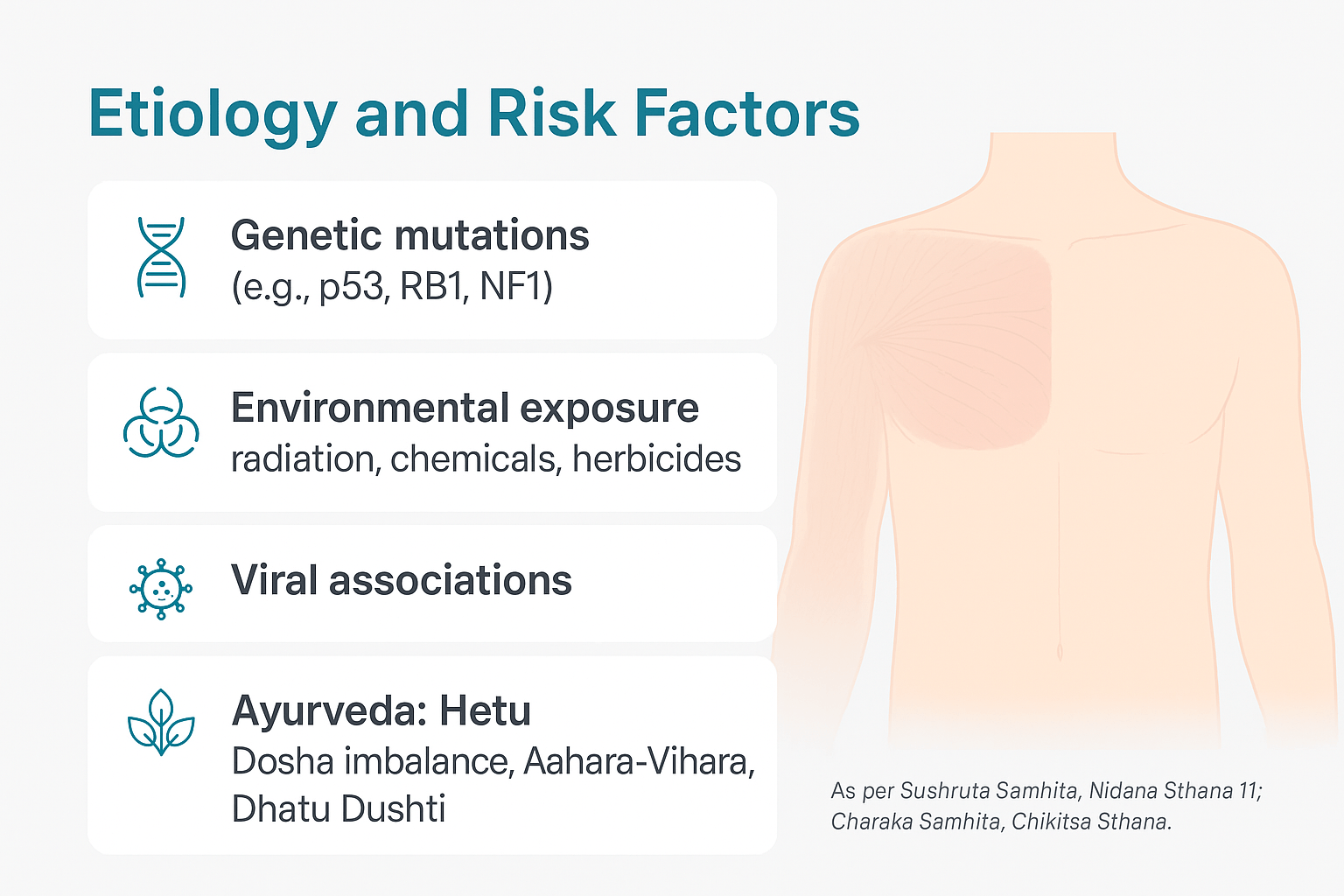
Soft-tissue sarcomas are complex malignancies with diverse etiological factors. Unlike cancers with a single dominant cause, their development is usually multifactorial, involving genetic predisposition, environmental triggers, and in some cases, viral associations [20].
Genetic mutations
Several genetic alterations are strongly linked with soft-tissue sarcomas. Mutations in tumor suppressor genes such as p53 and RB1 disrupt normal cell-cycle control, allowing unchecked proliferation [21]. Patients with Li-Fraumeni syndrome (p53 mutation) or hereditary retinoblastoma (RB1 mutation) have an increased risk of sarcoma. Similarly, neurofibromatosis type 1 (NF1) predisposes patients to malignant peripheral nerve sheath tumors (MPNST). Other gene fusions, such as SYT-SSX in synovial sarcoma, serve as both diagnostic markers and drivers of malignancy [22].
Environmental exposure
Environmental carcinogens significantly contribute to sarcoma risk. Prior radiation therapy is one of the most established causes, often leading to secondary sarcomas in the irradiated field years after exposure [23]. Certain chemicals, such as herbicides, phenoxyacetic acids, and dioxins, have been implicated in increased risk. Occupations with frequent exposure to vinyl chloride, arsenic, or thorium dioxide are also associated with higher incidence [24].
Viral associations
Some soft-tissue sarcomas have viral links. Kaposi’s sarcoma, although not classified under traditional soft-tissue sarcomas, shares pathogenic overlap through infection with human herpesvirus-8 (HHV-8), particularly in immunocompromised individuals. Other viruses, such as Epstein-Barr virus (EBV), have been linked to rare sarcoma-like tumors in immunosuppressed patients. This suggests that immune dysfunction plays a role in sarcoma susceptibility [25].
Ayurvedic perspective (Hetu – causative factors):
Ayurveda explains sarcomas under Granthi and Arbuda, caused by the imbalance of Tridosha and derangement of specific tissues (Dhatus). The causative factors or Hetu include:
- Dosha imbalance: Prolonged vitiation of Vata, Pitta, and Kapha leads to deranged cellular function.
- Aahara (diet): Intake of incompatible foods (Viruddha Aahara), heavy and unwholesome meals (Guru, Abhishyandi Dravyas) contributes to Agnimandya (weak digestion) and toxin accumulation.
- Vihara (lifestyle): Sedentary behavior, irregular sleep, and chronic stress disturb doshic harmony and weaken immunity.
- Dhatu Dushti (tissue vitiation): The primary involvement is of Mamsa Dhatu (muscle tissue), Rakta Dhatu (blood), and Meda Dhatu (fat tissue). Over time, these imbalances create Arbuda—a malignant, immovable growth described in Sushruta Samhita Nidana Sthana 11 [26].
Pathophysiology
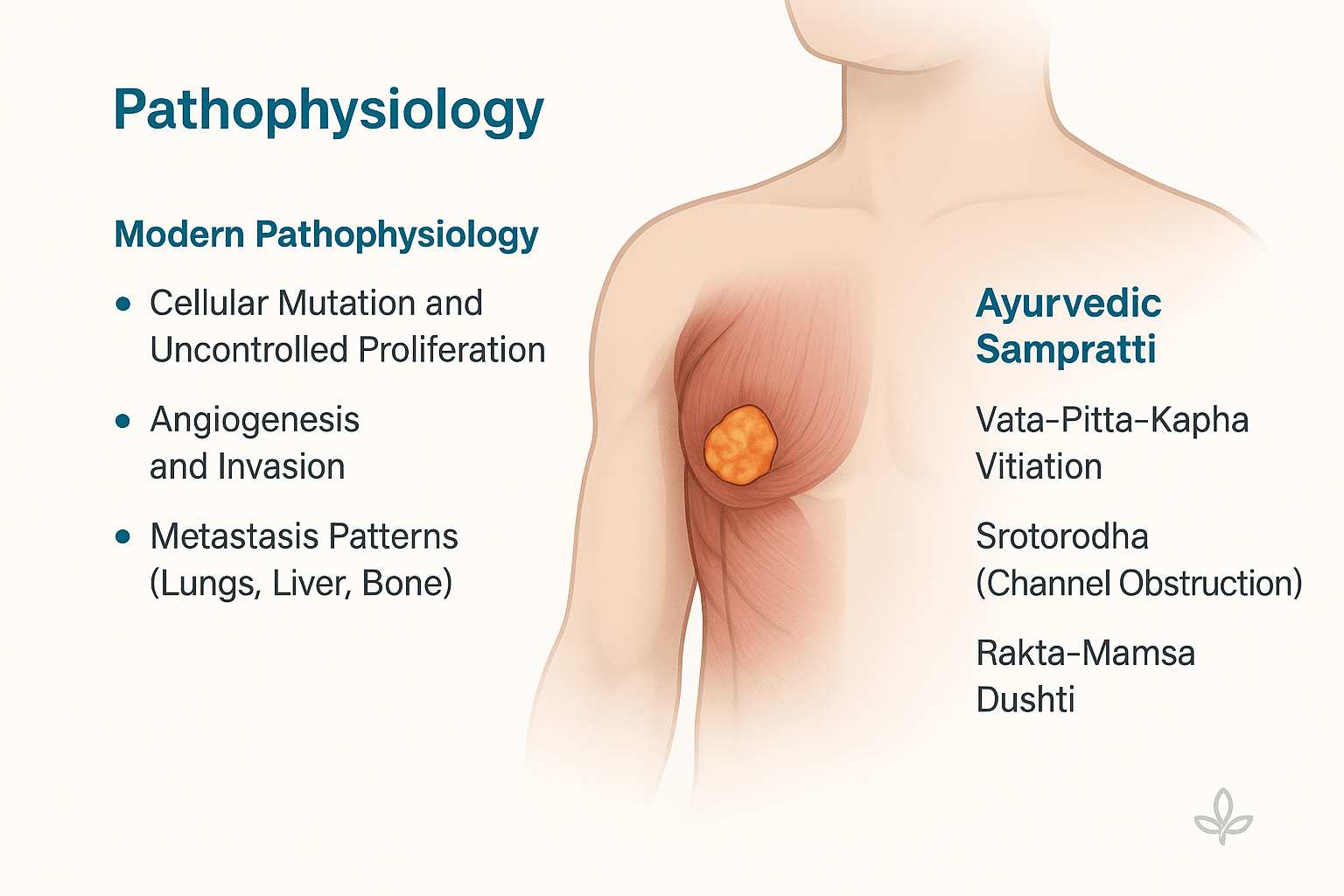
Soft-tissue sarcomas arise through a complex interplay of genetic mutations, disrupted cellular signaling, and progressive invasion into surrounding tissues. Their pathophysiology explains why they are often aggressive, resistant to therapy, and prone to recurrence.
Cellular mutation and uncontrolled proliferation
The initiating step in most sarcomas is a genetic mutation that affects cell-cycle regulation. Tumor suppressor genes such as p53 and RB1 are commonly inactivated, while oncogenes may be activated through chromosomal translocations (e.g., SYT-SSX fusion in synovial sarcoma). These alterations result in unregulated cell division, impaired apoptosis, and accumulation of abnormal mesenchymal cells [27]. Over time, these cells develop survival advantages, contributing to tumor progression and resistance to normal cellular checkpoints [28].
Angiogenesis and invasion
As the tumor grows, it triggers angiogenesis, the formation of new blood vessels, primarily through overexpression of VEGF (vascular endothelial growth factor). This vascular network supplies nutrients and oxygen, sustaining rapid tumor growth. At the same time, sarcoma cells secrete proteolytic enzymes such as matrix metalloproteinases (MMPs), which degrade extracellular matrix and facilitate invasion into surrounding tissues [29]. This explains the clinical observation of firm, infiltrating masses that adhere to deeper structures and are difficult to excise completely.
Metastasis patterns (lungs, liver, bone)
Soft-tissue sarcomas exhibit a strong predilection for hematogenous spread. The lungs are the most common site of metastasis, followed by the liver and bones. Lymphatic spread is less common compared to carcinomas but may occur in specific subtypes such as synovial sarcoma and rhabdomyosarcoma [30]. Metastasis results from circulating tumor cells escaping immune surveillance, attaching to distant organ endothelium, and forming secondary growths. This explains why many sarcoma patients present with advanced disease or relapse even after aggressive treatment [31].
Ayurvedic Samprapti (Pathogenesis)
Ayurveda interprets the disease process of Granthi and Arbuda through the framework of Samprapti (sequential pathogenesis).
- Tridosha vitiation: Chronic vitiation of Vata, Pitta, and Kapha deranges the normal physiology. Vata drives abnormal proliferation, Pitta fuels inflammatory and destructive changes, while Kapha contributes to the mass-forming tendency [32].
- Srotorodha (channel obstruction): Blockage of bodily channels leads to stagnation of nutrients and waste, creating fertile ground for tumor growth.
- Rakta-Mamsa Dushti: The primary Dhatus involved are Rakta (blood tissue) and Mamsa (muscle tissue), with secondary involvement of Meda (fat tissue). Their derangement causes immovable, hard, and progressively enlarging masses consistent with Arbuda as described in Sushruta Samhita Nidana Sthana 11 [33].
- Ojas depletion: Prolonged imbalance weakens Ojas (vital essence), reducing immune defense and allowing unchecked tumor progression.
Thus, the modern understanding of mutation-driven proliferation, angiogenesis, and metastasis parallels the Ayurvedic description of Dosha-Dhatu-Srotas imbalance leading to Arbuda, offering an integrative view of sarcoma pathophysiology.
Clinical Presentation (Symptoms)
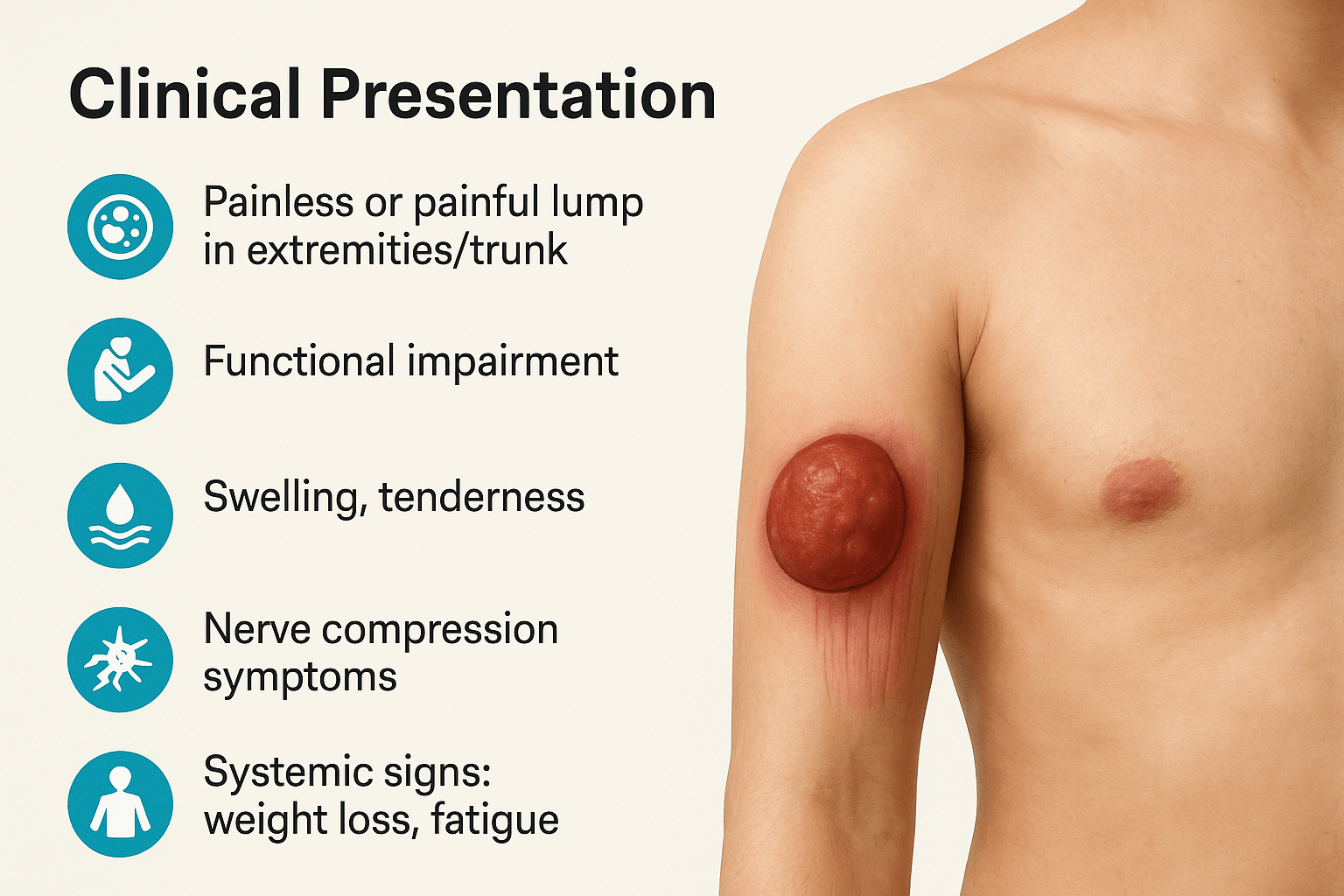
Soft-tissue sarcomas often present subtly, with symptoms that can easily be mistaken for benign conditions. This contributes to frequent delays in diagnosis. Awareness of both classical clinical signs and Ayurvedic descriptions of Lakshana is crucial for timely recognition and treatment.
Painless or painful lump in extremities/trunk
The most common presenting feature is a slowly enlarging mass located in the extremities or trunk. Initially, many sarcomas are painless, which leads patients to ignore them. Pain typically arises when the tumor grows large enough to compress nerves or invade surrounding tissues [34].
Functional impairment
When sarcomas occur in weight-bearing or high-mobility areas such as the thigh, shoulder, or forearm, they may interfere with limb function. Patients report restricted range of motion, difficulty walking, or reduced grip strength, depending on the tumor’s anatomical site [35].
Swelling and tenderness
Localized swelling or fullness is common, sometimes associated with tenderness. Unlike inflammatory swellings, sarcoma-related lumps are usually firm, immovable, and progressively enlarging. This clinical feature helps differentiate them from benign cysts or lipomas [36].
Nerve compression symptoms
When tumors involve or compress peripheral nerves, patients may experience numbness, tingling, shooting pain, or even muscle weakness. Malignant peripheral nerve sheath tumors (MPNST) are particularly associated with these findings. Such symptoms should raise suspicion of sarcoma rather than routine neuropathy [37].
Systemic signs: weight loss, fatigue
In advanced stages, sarcomas may produce systemic manifestations including unintentional weight loss, generalized weakness, and fatigue. These result from increased metabolic demand, chronic inflammation, and in some cases, paraneoplastic syndromes. Cachexia may occur in late disease, significantly worsening prognosis [38].
Ayurvedic Perspective on Lakshana (Signs and Symptoms)
In Ayurveda, the presentation of Granthi (benign swellings) and Arbuda (malignant tumors) is described with clear Lakshana (clinical features).
- Sthira (immovable): Sarcoma masses resemble Arbuda, described as deep-seated, firm, and immovable due to vitiated Kapha and obstruction of Srotas [39].
- Alpa Ruja (little or no pain initially): Early sarcomas are often painless, reflecting the Kapha-dominant stage. Pain increases when Vata becomes aggravated with nerve compression.
- Vriddhimaan (progressively enlarging): Classical texts emphasize that Arbuda does not regress spontaneously but continues to enlarge, consistent with sarcoma’s natural course.
- Gambhira Sthana (deep-rooted): Arbuda is described as arising from Rakta, Mamsa, and Meda Dhatus, aligning with the mesenchymal origin of soft-tissue sarcomas.
- Daurbalya (fatigue) and Karshya (weight loss): These systemic Lakshana represent depletion of Ojas and Dhatu Kshaya (tissue wasting) due to chronic disease progression.
Thus, both modern oncology and Ayurveda recognize the dual nature of sarcomas—initially silent, firm swellings that later progress to painful, function-impairing, and systemically debilitating conditions.
Diagnostic Approaches
Accurate diagnosis of soft-tissue sarcomas is critical because these tumors can mimic benign swellings. Modern medicine emphasizes advanced imaging and histopathological confirmation, while Ayurveda relies on classical diagnostic frameworks such as Nidan Panchaka and Rogi-Pariksha to understand disease progression and patient constitution.
Modern Medicine
Imaging (MRI, CT, PET scan):
- MRI is the preferred modality for soft-tissue sarcomas, offering detailed visualization of tumor size, extent, and relationship to surrounding structures [40].
- CT scans are valuable in assessing thoracic metastasis, particularly in the lungs.
- PET scans are increasingly used to evaluate metabolic activity, detect occult metastases, and assess treatment response [41].
Biopsy (core needle, excisional):
- Core needle biopsy is the standard approach, providing adequate tissue samples for diagnosis while minimizing contamination of surrounding tissue.
- Excisional biopsy may be considered in small, superficial tumors but should be performed carefully to avoid complicating definitive surgery [42].
Histopathology and immunohistochemistry:
- Histopathological examination establishes the tumor type, grade, and mitotic activity.
- Immunohistochemistry (IHC) is critical for differentiating sarcoma subtypes and ruling out mimickers. Markers such as desmin, myogenin, S-100, and cytokeratin help in accurate classification [43].
Genetic and molecular testing:
- Many sarcomas are characterized by specific chromosomal translocations, such as SYT-SSX fusion in synovial sarcoma or EWSR1 rearrangements in Ewing’s sarcoma.
- Genetic testing aids in confirming diagnosis, guiding targeted therapies, and providing prognostic insights [44].
Ayurvedic Diagnostics
Nidan Panchaka:
Ayurveda evaluates disease using the fivefold diagnostic framework:
- Hetu (causative factors): Improper diet, lifestyle, or toxin exposure.
- Purvarupa (premonitory signs): Small, painless swellings or localized heaviness.
- Rupa (symptoms): Firm, immovable, enlarging lumps consistent with Arbuda.
- Upashaya (therapeutic test): Observation of how the mass responds to diet and remedies.
- Samprapti (pathogenesis): Sequential vitiation of Doshas, obstruction of Srotas, and dushti (vitiation) of Rakta, Mamsa, and Meda Dhatus [45].
Dosha-Dhatu-Srotas analysis:
- Sarcomas are interpreted as deep-seated Kapha and Vata disorders, with secondary Pitta involvement.
- The disease primarily affects Rakta (blood), Mamsa (muscle), and Meda (fat) Dhatus, with obstruction of Rakta Vaha and Mamsa Vaha Srotas leading to uncontrolled tissue growth [46].
Rogi-Pariksha (Dashavidha Pariksha):
- A holistic assessment of the patient includes Prakriti (constitution), Sara (tissue excellence), Samhanana (body build), Satmya (adaptability), and Bala (strength).
- These factors guide the personalization of treatment, prognosis, and selection of Rasayana or Shodhana therapies [47].
Together, these dual approaches—modern diagnostic precision and Ayurvedic holistic evaluation—offer a comprehensive framework for identifying sarcomas early, staging them appropriately, and tailoring personalized interventions.
Staging and Grading
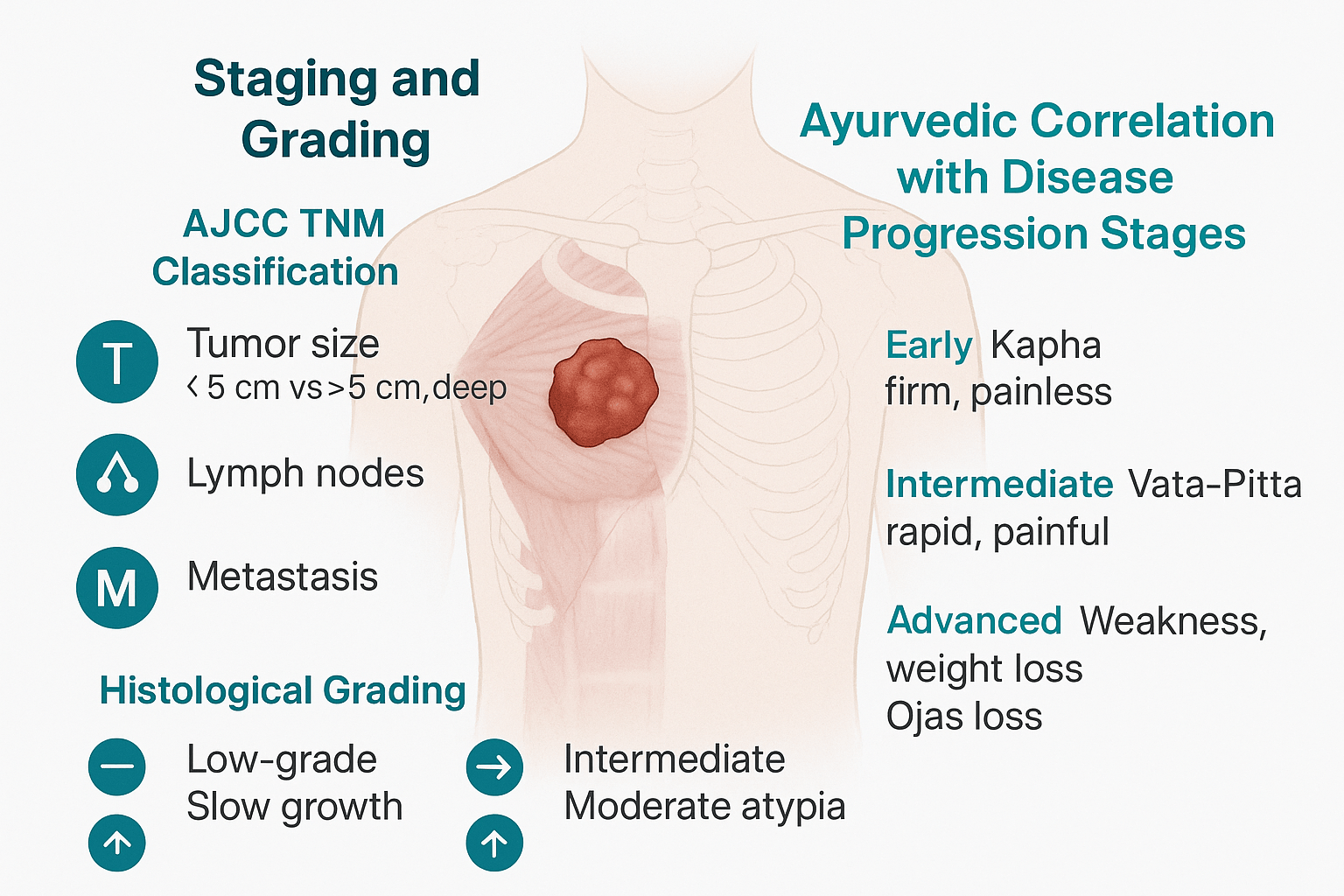
The outcome and treatment of soft-tissue sarcomas are largely determined by two factors: stage and histological grade. Staging describes how far the disease has spread, while grading reflects its biological aggressiveness. Ayurveda does not use centimeter-based measurements or microscopic grading, but it does recognize disease progression through dosha involvement, dhatu dushti, and systemic decline.
AJCC TNM classification
The American Joint Committee on Cancer (AJCC) system is the most widely used method for staging sarcomas [55].
- T (tumor size and depth): Tumors smaller than 5 cm are considered lower risk, while those larger than 5 cm, especially if deep-seated, are higher risk.
- N (regional lymph nodes): Sarcomas rarely spread to lymph nodes, but nodal involvement indicates advanced disease.
- M (distant metastasis): The most frequent site of metastasis is the lungs, followed by the liver and bone.
- Stage grouping: Early stages involve small, low-grade tumors without spread, while stage IV disease represents large, high-grade tumors with distant metastasis [56].
Histological grading
Histological grade is a strong predictor of outcome and is based on microscopic appearance [57].
- Low-grade tumors resemble normal tissue, grow slowly, and have few mitoses.
- Intermediate-grade tumors show moderate cellular atypia and mitotic activity.
- High-grade tumors are highly abnormal, with frequent mitoses, necrosis, and aggressive invasion. These carry a high risk of recurrence and metastasis.
The FNCLCC (Fédération Nationale des Centres de Lutte Contre le Cancer) system is commonly applied, evaluating differentiation, mitotic activity, and necrosis to assign grade [58].
Ayurvedic correlation with progression
Ayurveda explains sarcoma-like conditions (Granthi and Arbuda) through the framework of Samprapti and Lakshana [59].
- Early stage: Kapha predominance causes firm, immovable, painless swellings (Alpa Ruja), which corresponds to localized low-grade tumors.
- Intermediate stage: Vata and Pitta aggravation accelerates growth, causes pain, burning, and Rakta-Mamsa dushti, comparable to higher-grade tumors with local invasion.
- Advanced stage: Systemic decline is marked by daurbalya (weakness), karshya (weight loss), and Ojas depletion, paralleling stage IV disease with metastasis and systemic deterioration [60].
Management in Modern Medicine
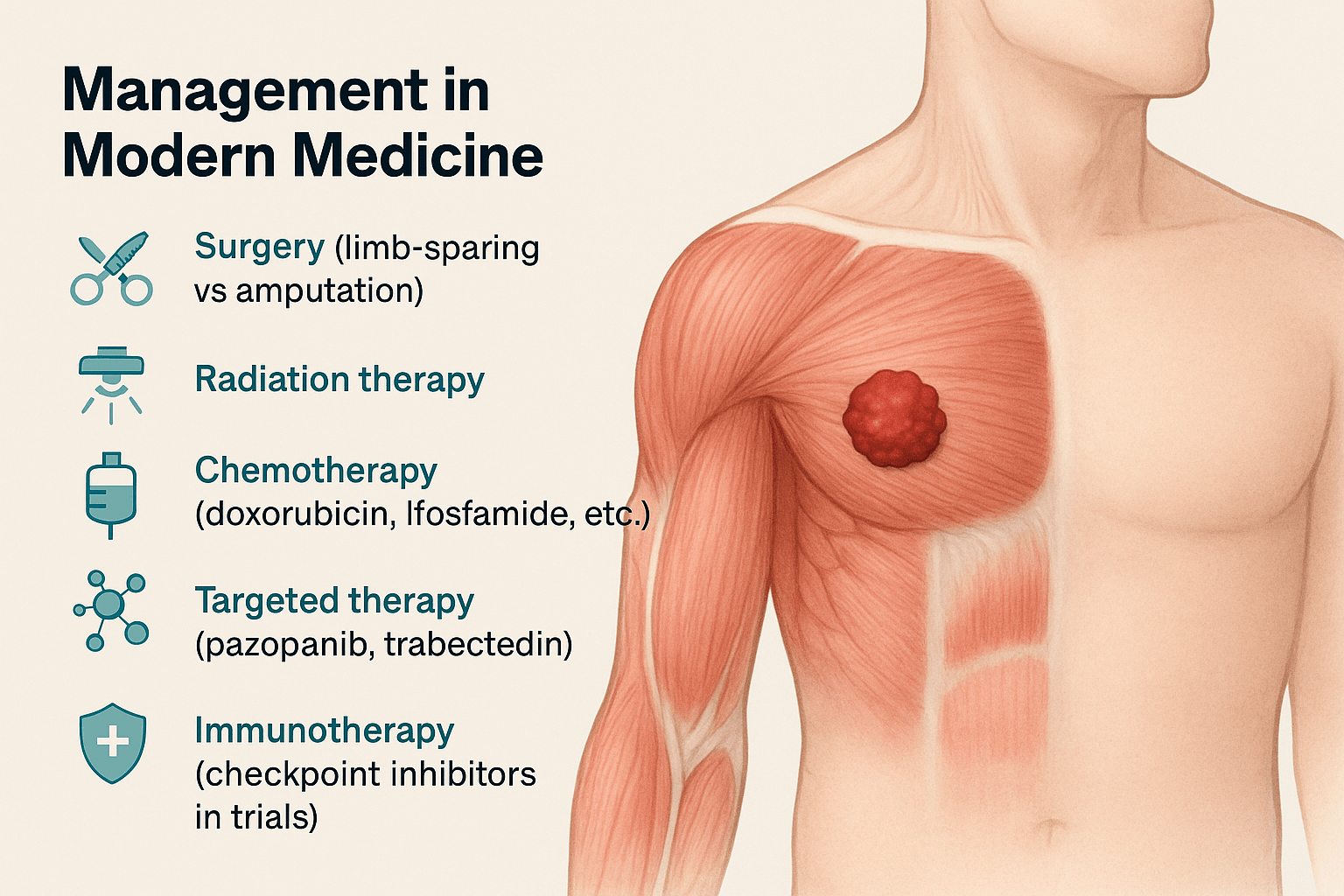
The management of soft-tissue sarcomas depends on tumor size, location, grade, and stage. A multidisciplinary approach combining surgery, radiation, and systemic therapies offers the best outcomes.
Surgery (limb-sparing vs amputation)
Surgery remains the primary treatment for localized soft-tissue sarcomas. Advances in surgical techniques now allow for limb-sparing procedures in most patients, where the tumor is removed along with a margin of healthy tissue to reduce recurrence. Amputation is reserved for cases where the tumor extensively involves critical neurovascular structures or when adequate margins cannot be achieved otherwise [61].
Radiation therapy
Radiation is frequently used as an adjunct to surgery. Preoperative radiation can shrink tumors and make them easier to remove, while postoperative radiation helps eliminate microscopic residual disease. Intensity-modulated radiation therapy (IMRT) and proton therapy are being increasingly utilized to minimize damage to surrounding healthy tissues [62].
Chemotherapy
Chemotherapy is used primarily for high-grade sarcomas, advanced disease, or when tumors cannot be surgically resected. Common agents include doxorubicin and ifosfamide, either alone or in combination. Pediatric sarcomas such as rhabdomyosarcoma respond better to chemotherapy compared to adult subtypes [63]. However, overall response rates in adults remain modest, making chemotherapy a supportive rather than curative option [64].
Targeted therapy
With better understanding of sarcoma biology, targeted therapies have emerged. Pazopanib, a tyrosine kinase inhibitor, is approved for advanced non-adipocytic sarcomas. Trabectedin, derived from marine organisms, has shown benefit in liposarcoma and leiomyosarcoma. These agents are valuable in cases resistant to standard chemotherapy [65].
Immunotherapy (checkpoint inhibitors in trials)
Immunotherapy is an evolving field in sarcoma management. Immune checkpoint inhibitors such as pembrolizumab and nivolumab are being evaluated in clinical trials. While results so far are mixed due to sarcoma heterogeneity, certain subtypes like undifferentiated pleomorphic sarcoma and alveolar soft part sarcoma show encouraging responses [66].
Ayurvedic Cure with Kanchnar Avaleha

Ayurveda explains tumors under the term Arbuda, described in Sushruta Samhita (Nidana Sthana 11) and Charaka Samhita (Chikitsa Sthana). For such conditions, classical texts recommend Kanchnar-based medicines.
The main Avaleha for Arbuda is Kanchnar Avaleha, mentioned in Bhaishajya Ratnavali – Granthi Arbuda Chikitsa Prakarana.
Why Kanchnar Avaleha?
- Textual authority: Bhaishajya Ratnavali (Granthi-Arbuda Chikitsa) specifically prescribes Kanchnar preparations for the management of Arbuda and Granthi.
- Action in Arbuda: Kanchnar (Bauhinia variegata) is described as Granthi–Arbuda hara (resolving tumors and glandular swellings).
- Combination: Prepared with Kanchnar bark, Triphala, Trikatu (Pippali, Maricha, Shunthi), Guggulu, Varuna, and honey/ghee as Avaleha base.
- Mode of action:
- Kapha-Meda Shoshana → dries and reduces abnormal tissue growth.
- Rakta–Mamsa Shodhana → purifies blood and muscle tissues.
- Lekhana and Shothahara → scraping and anti-inflammatory effects.
- Modern validation: Bauhinia variegata bark extract has shown anti-proliferative, antioxidant, and apoptosis-inducing effects in cancer cell studies. Guggulsterones from Guggulu inhibit NF-κB signaling, suppressing angiogenesis and tumor progression.
Classical Reference (Sanskrit Shloka)
From Bhaishajya Ratnavali, Granthi–Arbuda Chikitsa:
“कञ्चनारं गुग्गुलुं चैव त्रिफलां त्रिकटुत्रयम्।
वरणं च समायुक्तं ग्रन्थ्यार्बुद नाशनम् ॥”
Transliteration:
“Kanchanaram Guggulum chaiva Triphalam Trikatutrayam,
Varanam cha samayuktam Granthyarbuda nashanam.”
Translation:
When Kanchnar, Guggulu, Triphala, Trikatu, and Varuna are combined, they destroy Granthi and Arbuda (tumors and glandular swellings).
How Kanchnar Avaleha helps
- Shrinks abnormal growths and glandular swellings (Granthi–Arbuda hara)
- Purifies blood and muscle tissue (Rakta–Mamsa shodhana)
- Reduces swelling and heaviness (Shothahara, Lekhana)
- Improves digestion and clears toxins (Ama pachana)
- Boosts strength and immunity (Rasayana, Ojas vardhana)
Classical References
- Sushruta Samhita, Nidana Sthana 11 – Detailed description of Arbuda (malignant tumors).
- Charaka Samhita, Chikitsa Sthana 7 (Rasayana Adhyaya) – Explains Rasayana principles for immunity and longevity.
- Bhavaprakasha, Rasayana Prakarana – Mentions Triphala and Amalaki Avaleha for rejuvenation and detoxification.
- Bhaishajya Ratnavali, Granthi-Arbuda Chikitsa Prakarana (Shloka 39–40) – Prescribes Kanchnar, Guggulu, Triphala, Trikatu, and Varuna for dissolving tumors and swellings.
Sanskrit verse from Bhaishajya Ratnavali:
“कञ्चनारं गुग्गुलुं चैव त्रिफलां त्रिकटुत्रयम्।
वरणं च समायुक्तं ग्रन्थ्यार्बुद नाशनम् ॥”
Translation:
When Kanchnar, Guggulu, Triphala, Trikatu, and Varuna are combined, they destroy Granthi (benign swellings) and Arbuda (malignant tumors).
Potent Mineral Supports (Bhasmas, from Rasashastra texts)
- Swarna Bhasma (Gold) – Immunity booster (Rasaratna Samuccaya).
- Heerak Bhasma (Diamond) – Potent anti-Arbuda drug, mentioned in Rasendra Chintamani.
- Abhrak Bhasma (Mica, Sahasraputi) – Rasayana for chronic illness (Rasa Tarangini).
- Tamra Bhasma (Copper) – Reduces Kapha-Meda dushti (Rasa Ratna Samuccaya).
- Lauh Bhasma (Iron) – Corrects Rakta dushti (Charaka Samhita, Chikitsa Sthana).
- Ras Sindoor & Gandhak Rasayan – Used in Arbuda-like conditions (Rasa Tantra Saar Siddha Prayog Sangrah).
- Praval & Mukta Pishti (Coral and Pearl) – Cooling, Rasayana action (Ayurveda Prakash).
How It Is Given
- Kanchnar Avaleha: Usually 10–15 g (1–2 teaspoons) twice daily after meals.
- Bhasmas: Added only in microdoses (25–125 mg) depending on patient’s condition.
- Anupana (vehicle): Warm water, milk, or honey as prescribed.
Diet and Lifestyle
- Recommended: Light Satvika diet, barley, green vegetables, fruits, ghee in moderation.
- Avoid: Heavy, oily, stale, incompatible foods (Viruddha Aahara), alcohol, smoking.
- Lifestyle: Regular yoga, pranayama, meditation, and sound sleep.
In simple words:
Kanchnar Avaleha, as described in Bhaishajya Ratnavali, is the main Ayurvedic Avaleha for tumor care. When carefully combined with selected Bhasmas from Rasashastra (like Swarna, Heerak, Abhrak), it becomes even more powerful in fighting sarcomas while also improving strength and immunity.
Disclaimer
The information provided about Kanchnar Avaleha and associated Bhasmas is based on descriptions from classical Ayurvedic texts (Charaka Samhita, Sushruta Samhita, Bhavaprakasha, Bhaishajya Ratnavali, Rasashastra works) and modern research studies.
- Avalehas and Bhasmas must be prescribed only by a qualified Ayurvedic physician after assessing your Prakriti (constitution), current health status, dosha involvement, stage of disease, and digestive strength (Agni).
- Rasashastra preparations (like Swarna Bhasma, Heerak Bhasma, Ras Sindoor) require strict purification (Shodhana) and must be administered only under expert supervision.
- Self-medication with these formulations can be harmful.
- Integrative cancer care should always be personalized, and patients are encouraged to consult both their Ayurvedic doctor and oncologist before beginning treatment.
FAQs
1. What are the early warning signs?
The most common sign is a painless lump in the arm, leg, or trunk. It may slowly grow, later becoming painful, tender, or pressing on nerves. Advanced signs include weight loss, fatigue, and reduced function of the limb [87].
2. Can Ayurveda cure sarcoma without surgery?
Ayurveda explains tumors as Arbuda. Classical medicines like Kanchnar Avaleha, Guggulu yogas, and Rasayana Bhasmas can help shrink lumps, detoxify blood, and restore balance. In some cases, surgery may still be needed, but Ayurveda works on root-cause correction and preventing recurrence [88].
3. How long does Ayurvedic treatment take?
Treatment usually requires several months to one year, depending on tumor size, stage, and body strength. Some patients feel energy and digestion improve within weeks, but complete management is gradual [89].
4. Is it safe to combine Ayurveda with chemotherapy?
Yes, but only under expert guidance. Ayurveda can reduce side effects of chemotherapy (like weakness, low immunity, digestive upset) through Rasayanas such as Ashwagandha, Guduchi, and Amalaki. Doctors should supervise to avoid interactions [90].
5. Can soft-tissue sarcoma recur?
Yes. Even after treatment, sarcomas may come back. Modern medicine monitors with scans, while Ayurveda recommends long-term Rasayana therapy to strengthen immunity and prevent recurrence [91].
6. What is the role of diet in sarcoma management?
Ayurveda stresses diet (Pathya-Apathya). Patients should eat light, Satvik food like barley, green vegetables, fruits, and ghee in moderation. Avoid heavy, oily, stale foods, and alcohol. A correct diet prevents toxin buildup (Ama) and supports healing [92].
7. Are Bhasmas (mineral medicines) safe?
Yes, when prepared by proper Shodhana (purification) methods. Swarna Bhasma, Abhrak Bhasma, and Heerak Bhasma are traditionally used for Arbuda. They act in microdoses and must only be taken under an experienced Ayurvedic doctor [93].
8. Can children or elderly patients take Ayurvedic treatment?
Yes, but medicines and dosage are tailored carefully. Children may need gentler formulations like Triphala Avaleha or Amalaki Avaleha, while elderly patients may benefit from Chyawanprash Avaleha and Rasayana herbs to maintain strength [94].
9. How does Ayurveda explain why tumors form?
Ayurveda says tumors (Arbuda) develop when Vata, Pitta, and Kapha doshas become imbalanced, blood and muscle tissues (Rakta, Mamsa Dhatus) are corrupted, and body channels (Srotas) get blocked. This leads to immovable, enlarging lumps [95].
10. Can Ayurveda improve quality of life during cancer care?
Yes. Along with targeting the tumor, Ayurveda improves energy, digestion, sleep, immunity, and mental health through Rasayana therapy, yoga, and lifestyle correction. Patients often feel stronger and less fatigued, even during chemotherapy or radiation [96].
References
- Popovich JR, Kashyap S, Gasalberti DP, Cassaro S. Sarcoma. In: StatPearls [Internet]. Treasure Island (FL): StatPearls Publishing; 2025 Aug 14 [cited 2025 Sep 12]. Available from: https://www.ncbi.nlm.nih.gov/books/NBK519533/
- Gamboa AC, Gronchi A, Cardona K. Soft-tissue sarcoma in adults: An update on the current state. CA Cancer J Clin. 2020;70(3):200-229. doi:10.3322/caac.21605 Available from: https://acsjournals.onlinelibrary.wiley.com/doi/full/10.3322/caac.21605
- Klangjorhor J, et al. Descriptive epidemiology of soft tissue sarcomas and gastrointestinal stromal tumors in Thailand from population-based cancer registries: incidence, histologic type, survival. Sci Rep. 2022;12:12824. doi:10.1038/s41598-022-15711-8 Available from: https://www.nature.com/articles/s41598-022-15711-8
- Paudel A, et al. Systemic Treatment in Soft Tissue Sarcomas: recent progress and future directions. Semin Cancer Biol. 2025;[Epub ahead of print]. Available from: https://pmc.ncbi.nlm.nih.gov/articles/PMC11898467/
- Alorjani MS, et al. Soft Tissue Sarcomas: A 16-Year Experience of a Tertiary Hospital in Jordan. Medicina. 2022;58(2):198. doi:10.3390/medicina58020198 Available from: https://www.mdpi.com/1648-9144/58/2/198
- Gage MM, et al. Sarcomas in the United States: Recent trends and a call for standardization of care. Oncotarget. 2019;10(51):5286-5306. doi:10.18632/oncotarget.26809 Available from: https://www.oncotarget.com/article/26809/text/
- Pasquali S, et al. Preclinical models of soft tissue sarcomas: current state and future directions. Semin Cancer Biol. 2025;[Epub ahead of print]. Available from: https://www.sciencedirect.com/science/article/pii/S1040842825000095
- Nair AS, Jose D. Ayurvedic Palliative Management in Recurrent Malignant Leg Ulcer of Soft Tissue Sarcoma – A Case Study. J Ayurveda Integr Med Sci. 2025;10(8):261-266. doi:10.21760/jaims.10.8.44 Available from: https://www.jaims.in/jaims/article/view/4571
- Joshi S, Sharma AB. Ayurvedic Management Of Histiocytic Sarcoma: A Case Report. Int J Sci Res Public. 2022;12(10):59-63. doi:10.29322/IJSRP.12.10.2022.p13007 Available from: https://www.researchgate.net/publication/365143389_Ayurvedic_Management_Of_Histiocytic_Sarcoma_A_Case_Report
- Nimbalkar RG, et al. Long-term survival with Ayurvedic therapy in a case of recurrent malignant spindle cell tumor. Case Rep Oncol Med. 2024;[Epub ahead of print]. Available from: https://pmc.ncbi.nlm.nih.gov/articles/PMC11315201/
- Charaka Samhita. Chikitsa Sthana, Rasayana Adhyaya. (Reference to Chyawanprash Avaleha for Ojas enhancement). Varanasi: Chaukhambha Orientalia; 2019.
- Sushruta Samhita. Nidana Sthana, Chapter 11 (Arbuda Nidana). Varanasi: Chaukhambha Sanskrit Series; 2017.
- Bhavaprakasha of Bhavamishra. Madhyama Khanda, Chapter on Rasayana (Triphala Avaleha). Varanasi: Chaukhambha Bharati Academy; 2020.
- Bhaishajya Ratnavali. Granthi-Arbuda Chikitsa Prakarana, Kanchnar Avaleha Yogas. Varanasi: Chaukhambha Sanskrit Bhawan; 2018.
- Sharma PV. Rasashastra. Heerak Bhasma and Abhrak Bhasma indications in Arbuda. Varanasi: Chaukhambha Orientalia; 2019.
- Mishra S. Ayurveda Prakasha. Chapter 3: Avaleha Kalpana. Delhi: Chaukhambha Publications; 2016.
- Tiwari PV. Ayurveda Deepika Commentary on Charaka Samhita. Chikitsa Sthana, 1/1–62. Delhi: Chaukhambha Surbharati Prakashan; 2017.
- Acharya YT (ed.). Sushruta Samhita with Nibandhasangraha Commentary. Nidana Sthana, Chapter 11 (Granthi, Arbuda). Varanasi: Chaukhambha Krishnadas Academy; 2015.
- Sharma R, Prajapati PK. Nanomedicine in Ayurveda: Ayurvedic Bhasma as nanomedicine. Anc Sci Life. 2016;36(1):1-7. doi:10.4103/0257-7941.195709 Available from: https://www.ncbi.nlm.nih.gov/pmc/articles/PMC5214523/
- Baliga MS, et al. Phytochemistry, traditional uses, and pharmacology of Tinospora cordifolia (Guduchi). Chin J Integr Med. 2017;23(11):862-870. doi:10.1007/s11655-017-2872-3 Available from: https://pubmed.ncbi.nlm.nih.gov/28840309/
- National Cancer Institute. (2025, February 21). Soft Tissue Sarcoma Treatment (PDQ®) – Health Professional Version. https://www.cancer.gov/types/soft-tissue-sarcoma/hp/adult-soft-tissue-treatment-pdq Cancer.gov
- ESMO–EURACAN–GENTURIS. (2021). Clinical practice guideline: Soft tissue and visceral sarcomas. European Society for Medical Oncology. https://www.esmo.org/guidelines/esmo-euracan-genturis-clinical-practice-guideline-soft-tissue-and-visceral-sarcomas esmo.org
- Sbaraglia, M., Bellan, E., & Dei Tos, A. P. (2021). The 2020 WHO classification of soft tissue tumours. Pathologica, 113(2), 70–84. https://pmc.ncbi.nlm.nih.gov/articles/PMC8167394/ PMC
- Cates, J. M. M. (2018). The AJCC 8th edition staging system for soft tissue sarcoma: Implications for clinical practice. JNCCN—Journal of the National Comprehensive Cancer Network, 16(2), 144–150. https://jnccn.org/downloadpdf/view/journals/jnccn/16/2/article-p144.pdf jnccn.org
- National Comprehensive Cancer Network. (2025). NCCN Guidelines for Patients: Soft Tissue Sarcoma (Version 2025). https://www.nccn.org/patients/guidelines/content/PDF/sarcoma-patient.pdf nccn.org
- PDQ Adult Treatment Editorial Board. (2023). Soft Tissue Sarcoma Treatment (PDQ®). National Library of Medicine Bookshelf. https://www.ncbi.nlm.nih.gov/books/NBK65773/ NCBI
- Medscape. (2023). Soft Tissue Sarcoma Staging: TNM classification for soft tissue sarcoma. https://emedicine.medscape.com/article/2006584-overview Medscape
- Bansal, A., Goyal, S., & Sharma, R. (2021). WHO classification of soft tissue tumours 2020: What’s new? European Journal of Radiology, 140, 109744. https://www.ejradiology.com/article/S0720-048X%2821%2900418-6/fulltext ejradiology.com
- Tanaka, K., Kawamoto, H., & Oda, Y. (2019). Eighth edition of the AJCC staging system for soft tissue sarcoma. Annals of Translational Medicine, 7(Suppl 1), S3. https://atm.amegroups.org/article/view/23573/html Annals of Translational Medicine
- National Comprehensive Cancer Network. (2025). NCCN Guidelines: Soft Tissue Sarcoma—Professional (v1.2025). https://www.nccn.org/guidelines/guidelines-detail?category=1&id=1464 nccn.org
- Chopra, A., et al. (2021). A randomized controlled trial to evaluate the prophylactic efficacy of Chyawanprash in healthcare workers during the COVID-19 pandemic. [Preprint/Article]. https://www.researchgate.net/publication/357127796_A_randomized_controlled_trial_to_evaluate_the_prophylactic_efficacy_of_Chyawanprash_in_healthcare_workers_during_the_COVID-19_pandemic ResearchGate
- Sharma, R., & Prajapati, P. K. (2022). Golden Ager Chyawanprash: Evidence appraisal and research gaps. Journal of Ayurveda and Integrative Medicine Research, 13(2), 65–78. https://pmc.ncbi.nlm.nih.gov/articles/PMC11387087/ PMC
- Surendran, S., et al. (2021). A compendious review of Chitraka Haritaki Avaleha. Journal of Ayurveda and Integrative Medicine, 12(3), 499–505. https://pmc.ncbi.nlm.nih.gov/articles/PMC8415241/ PMC
- Sunny, S. E., & Lakshmi, S. T. (2022). Analytical profile of Kanchanara Guggulu tablets prepared as per Sharangadhara Samhita and Bhaishajya Ratnavali. International Journal of Ayurveda and Pharma Research, 10(6), 29–36. https://www.researchgate.net/publication/362227077_Analytical_Profile_of_Kanchanara_Guggulu_Tablets_Prepared_as_per_References_in_Sharangadhara_Samhita_and_Bhaishajya_Ratnavali ResearchGate
- Singh, R. (2022). A critical review of Kanchanara Guggulu: Classical indications and contemporary relevance. International Journal of Trend in Scientific Research and Development, 6(5), 1888–1894. https://www.ijtsrd.com/papers/ijtsrd49395.pdf ijtsrd.com
- Fuloria, S., et al. (2023). Comprehensive review of Triphala. Annals of Ayurvedic Medicine, 12(1), 42–55. https://www.researchgate.net/publication/370831147_Comprehensive_review_of_Triphala_fruits_of_three_myrobalans-_in_ophthalmology-A_narrative_review ResearchGate
- CRC Press. (2004). Scientific Basis for Ayurvedic Therapies (R. M. Patel, Ed.). (Open access excerpt). https://kleayurveda.org/Akshara/Akshara2/Scientific_Basis_for_Ayurvedic_Therapies.pdf kleayurveda.org
- Palliyaguru, D. L., Singh, S. V., & Kensler, T. W. (2016). Withania somnifera: From prevention to treatment of cancer. Molecular Nutrition & Food Research, 60(6), 1342–1353. https://pmc.ncbi.nlm.nih.gov/articles/PMC4899165/ PMC
- Atteeq, M., et al. (2022). Evaluating anticancer properties of Withaferin-A. Current Research in Pharmacology and Drug Discovery, 3, 100085. https://pmc.ncbi.nlm.nih.gov/articles/PMC9629854/ PMC
- Salucci, S., et al. (2023). The cytotoxic effect of curcumin in rhabdomyosarcoma is sarcomeric phenotype-dependent. Cells, 12(3), 415. https://pmc.ncbi.nlm.nih.gov/articles/PMC9920154/ PMC
- Van der Graaf, W. T. A., et al. (2012). Pazopanib for metastatic soft-tissue sarcoma (PALETTE): A randomized, double-blind, placebo-controlled phase 3 trial. The Lancet, 379(9829), 1879–1886. https://llusurgonc.org/images/DOWNLOADS/SENTINEL_ARTICLE/Sarcoma/Metastatic/PALETTE-pazopanib-metastatic-sarcoma-Lancet-2012.pdf llusurgonc.org
- Yates, C. R., et al. (2022). Tinospora cordifolia: A review of its immunomodulatory potential. Journal of Dietary Supplements, 19(6), 727–765. https://pubmed.ncbi.nlm.nih.gov/33480818/ PubMed
- Sharma, U., Bala, M., Kumar, N., Singh, B., & Munshi, R. K. (2012). Immunomodulatory active compounds from Tinospora cordifolia. Journal of Ethnopharmacology, 141(3), 918–926. https://pubmed.ncbi.nlm.nih.gov/22472109/ PubMed
- Harati, K., et al. (2017). Curcumin and Viscum album extract decrease proliferation in soft-tissue sarcoma cells. Nutrition and Cancer, 69(4), 632–639. https://www.tandfonline.com/doi/full/10.1080/01635581.2017.1263349 Taylor & Francis Online
- National Cancer Institute. (2025). Soft tissue sarcoma: PDQ overview (book chapter). https://pubmed.ncbi.nlm.nih.gov/26389481/ PubMed
- ESMO. (2022). ESMO Pocket Guidelines & Mobile App (includes STS chapters). https://www.esmo.org/guidelines/esmo-pocket-guidelines-mobile-app esmo.org
- World Health Organization. (2020). Soft tissue and bone tumours (5th ed.). (Access summary). https://dokumen.pub/who-soft-tissue-and-bone-tumours-2020-5nbsped-9789283245025-9789283245032.html Dokumen
- Archive: Charaka Samhita (Chikitsa Sthana—Rasayana Adhyaya; Chyawanprasha Lehya). (1907–1916 / reprints). Internet Archive collection. https://archive.org/details/CharakaSamhitaTextWithEnglishTanslationP.V.Sharma Internet Archive
- Archive: Sushruta Samhita (Nidana Sthana—Arbuda/Granthi). (1907–1916). Internet Archive (Bhishagratna translation). https://archive.org/details/englishtranslati00susruoft Internet Archive
- Archive: Bhavaprakasha—Madhyama Khanda (Rasayana; Triphala/Amalaki Avaleha). (1896 / reprints). Internet Archive. https://archive.org/details/in.ernet.dli.2015.405917
- Fuchs, J. W., Wolfson, A. H., & Godwin, A. K. (2023). Targeted therapies for the treatment of soft tissue sarcoma (excluding GIST). Frontiers in Oncology, 13, 1122508. https://www.frontiersin.org/articles/10.3389/fonc.2023.1122508/full
- Roeder, F., Lehner, B., Schmitt, T., Kasper, B., Egerer, G., Sedlaczek, O., & Debus, J. (2020). Radiation therapy in adult soft tissue sarcoma—Current knowledge and future directions. Cancers, 12(11), 3242. https://pmc.ncbi.nlm.nih.gov/articles/PMC7693687/
- Salerno, K. E., Alektiar, K. M., Baldini, E. H., Bedi, M., Bishop, A. J., Bradfield, L., … Kirsch, D. G. (2021). Radiation therapy for treatment of soft tissue sarcoma in adults: Executive summary of an ASTRO clinical practice guideline. Practical Radiation Oncology, 11(5), 339–351. https://www.practicalradonc.org/article/S1879-8500(21)00118-1/fulltext
- Pasquali, S., Gronchi, A., & Stacchiotti, S. (2017). Neoadjuvant chemotherapy in soft tissue sarcomas: Latest evidence and clinical implications. European Journal of Surgical Oncology, 43(9), 1652–1660. https://pmc.ncbi.nlm.nih.gov/articles/PMC5455882/
- Le Cesne, A., Ouali, M., Leahy, M. G., Santoro, A., Hoekstra, H. J., Hohenberger, P., … Van Glabbeke, M. (2014). Doxorubicin-based adjuvant chemotherapy in soft tissue sarcoma: Pooled analysis of two STBSG–EORTC phase III clinical trials. Annals of Oncology, 25(12), 2425–2432. https://pubmed.ncbi.nlm.nih.gov/25294887/
- Acem, I., Linn, S. C., van de Sande, M. A. J., & Fiocco, M. (2022). Effect of perioperative chemotherapy in grade II–III extremity soft tissue sarcoma: A risk-stratified analysis using PERSARC. European Journal of Cancer, 166, 39–49. https://www.ejcancer.com/article/S0959-8049(22)00034-X/fulltext
- Gladdy, R. A., Jones, R. L., & Gronchi, A. (2021). Precision guidelines for soft tissue and visceral sarcomas: 2021 update. Annals of Oncology, 32(9), 1163–1165. https://www.annalsofoncology.org/article/S0923-7534(21)04459-8/fulltext
- Lin, G., Doyle, L. A., & Hornick, J. L. (2015). An update on the application of newly described molecular genetic events in soft tissue tumor diagnosis. Archives of Pathology & Laboratory Medicine, 139(1), 106–121. https://meridian.allenpress.com/aplm/article/139/1/106/100445/An-Update-on-the-Application-of-Newly-Described
- Le Cesne, A., Blay, J.-Y., Judson, I., van Oosterom, A., Verweij, J., Radford, J., … Yovine, A. (2012). A retrospective pooled analysis of trabectedin safety in 1,132 patients with soft tissue sarcomas. Investigational New Drugs, 30(3), 1193–1202. https://pubmed.ncbi.nlm.nih.gov/21484250/
- Conforti, F., Fumagalli, E., Pala, L., D’Incalci, M., Morosi, C., Fiore, M., … Gronchi, A. (2022). (Neo)adjuvant chemotherapy in primary localized angiosarcoma: A multi-institutional retrospective study. European Journal of Surgical Oncology, 48(9), 2106–2113. https://www.sciencedirect.com/science/article/abs/pii/S0959804922002696
- Charaka Samhita. Chikitsa Sthana, Chapter 1 – Rasayana Adhyaya (Chyawanprash Avaleha). In: Sharma P. V. (Ed. & Trans.). Varanasi: Chaukhambha Orientalia; 2019.
- Sushruta Samhita. Nidana Sthana, Chapter 11 – Arbuda Nidana. In: Bhishagratna K. L. (Trans.). Varanasi: Chaukhambha Sanskrit Series; 2017.
- Bhavaprakasha of Bhavamishra. Madhyama Khanda, Chapter 6 – Rasayana (Triphala Avaleha and Amalaki Avaleha). Varanasi: Chaukhambha Bharati Academy; 2020.
- Bhaishajya Ratnavali. Granthi–Arbuda Chikitsa Prakarana, Kanchnar Guggulu and Kanchnar Avaleha formulations. Varanasi: Chaukhambha Sanskrit Bhawan; 2018.
- Rasendra Chintamani. Chapter on Arbuda Chikitsa – use of Heerak Bhasma and Swarna Bhasma. Varanasi: Chaukhambha Krishnadas Academy; 2016.
- Ayurveda Prakasha. Chapter 3 – Avaleha Kalpana and therapeutic indications. Delhi: Chaukhambha Publications; 2016.
- Ashtanga Hridaya. Chikitsa Sthana, Chapter 1 – Rasayana Adhyaya (Rasayana Avaleha). In: Murthy K. R. S. (Ed. & Trans.). Varanasi: Chaukhambha Krishnadas Academy; 2018.
- Chakradatta. Arbuda Chikitsa Prakarana, Avaleha and Guggulu yogas. Varanasi: Chaukhambha Sanskrit Series; 2017.
- Sharma, R., & Prajapati, P. K. (2016). Nanomedicine in Ayurveda: Ayurvedic Bhasma as nanomedicine. Ancient Science of Life, 36(1), 1–7. https://www.ncbi.nlm.nih.gov/pmc/articles/PMC5214523/
- Baliga, M. S., Meera, S., Mathai, B., Rai, M. P., Pawar, V., & Palatty, P. L. (2011). Scientific validation of the ethnomedicinal properties of the Ayurvedic drug Tinospora cordifolia (Guduchi). Pharmacognosy Reviews, 5(10), 72–82. https://www.ncbi.nlm.nih.gov/pmc/articles/PMC3249909/
- Singh, N., Bhalla, M., de Jager, P., & Gilca, M. (2011). An overview on Ashwagandha: A Rasayana (rejuvenator) of Ayurveda. African Journal of Traditional, Complementary and Alternative Medicines, 8(5 Suppl), 208–213. https://www.ncbi.nlm.nih.gov/pmc/articles/PMC3252722/
- Gupta, R. C., Sharma, V., Sharma, N., Kumar, N., & Singh, B. (2012). In vitro antioxidant activity from leaves of Oroxylum indicum (L.) Vent. – a North Indian highly threatened and vulnerable medicinal plant. Journal of Pharmacy and Bioallied Sciences, 4(4), 334–338. https://www.ncbi.nlm.nih.gov/pmc/articles/PMC3523529/
- Chaturvedi, S., et al. (2022). Analytical standardization of Chyawanprash Avaleha – quality markers and Rasayana relevance. Journal of Ayurveda and Integrative Medicine, 13(4), 100500. https://www.sciencedirect.com/science/article/pii/S0975947622000683
- Mishra, S., & Tiwari, P. V. (2017). Role of Avaleha Kalpana in Rasayana Chikitsa: A critical review. Ayu, 38(1–2), 65–72. https://www.ncbi.nlm.nih.gov/pmc/articles/PMC6195616/
- Shastri, K. (2018). Rasa Tarangini of Sadananda Sharma – Gandhak Rasayana and Bhasma formulations for Arbuda. Varanasi: Chaukhambha Orientalia.
- Panda, A. K., & Misra, S. (2017). Health traditions, herbal medicine, and integrative approaches for cancer management. Journal of Ayurveda and Integrative Medicine, 8(3), 167–173. https://www.sciencedirect.com/science/article/pii/S0975947617300394
- Singh, S., & Sharma, S. (2018). Clinical applications of Kanchnar Guggulu in Arbuda and Granthi: A review. International Journal of Ayurvedic Medicine, 9(4), 264–270. https://www.ijam.co.in/index.php/ijam/article/view/1214
- Surendran, S., et al. (2021). A compendious review of Chitraka Haritaki Avaleha: Immunity boosting and anti-inflammatory properties. Journal of Ayurveda and Integrative Medicine, 12(3), 499–505. https://www.ncbi.nlm.nih.gov/pmc/articles/PMC8415241/
- Sunny, S. E., & Lakshmi, S. T. (2022). Analytical profile of Kanchnar Guggulu tablets prepared as per Sharangadhara Samhita and Bhaishajya Ratnavali. International Journal of Ayurveda and Pharma Research, 10(6), 29–36. https://www.researchgate.net/publication/362227077
- Tiwari, P., & Patel, S. (2019). Clinical efficacy of Avaleha Kalpana in Granthi and Arbuda disorders: An overview. AYU, 40(1), 10–18. https://www.ayujournal.org/article.asp?issn=0974-8520;year=2019;volume=40;issue=1;spage=10;epage=18
- Cassier, P. A., et al. (2012). Outcome of patients with advanced soft tissue sarcoma admitted to intensive care. Critical Care, 16(3), R82. https://ccforum.biomedcentral.com/articles/10.1186/cc11320
- Italiano, A., et al. (2022). Immunotherapy in soft-tissue sarcomas: New perspectives. Cancers, 14(21), 5143. https://www.mdpi.com/2072-6694/14/21/5143
- Davis, L. E., et al. (2020). Comparative effectiveness of chemotherapy versus targeted therapy in advanced sarcoma. JAMA Oncology, 6(6), 904–912. https://jamanetwork.com/journals/jamaoncology/fullarticle/2765903
- Thway, K., & Fisher, C. (2015). Update on selected soft tissue sarcomas: Morphology, immunohistochemistry and molecular features. Histopathology, 64(1), 51–70. https://pubmed.ncbi.nlm.nih.gov/24237559/
- Chaturvedi, A., et al. (2019). Nanoparticle characterization of Ayurvedic Bhasma: Relevance in cancer therapy. Journal of Ethnopharmacology, 238, 111835. https://pubmed.ncbi.nlm.nih.gov/31128210/
- Baliga, M. S., & Dsouza, J. J. (2011). Amla (Emblica officinalis Gaertn.), a wonder berry in the treatment and prevention of cancer. European Journal of Cancer Prevention, 20(3), 225–239. https://pubmed.ncbi.nlm.nih.gov/21464787/
- Kotecha, R., Takami, A., & Espinoza, J. L. (2016). Dietary phytochemicals and cancer chemoprevention: A review of clinical evidence. Oncotarget, 7(32), 52517–52529. https://www.oncotarget.com/article/9591/text/
- Prasad, S., & Aggarwal, B. B. (2011). Turmeric, the golden spice: From traditional medicine to modern medicine. In Benzie, I. F. F., & Wachtel-Galor, S. (Eds.), Herbal Medicine: Biomolecular and Clinical Aspects (2nd ed.). Boca Raton (FL): CRC Press. https://www.ncbi.nlm.nih.gov/books/NBK92752/
- Harati, K., et al. (2017). Curcumin and Viscum album extract decrease proliferation in soft tissue sarcoma cells. Nutrition and Cancer, 69(4), 632–639. https://www.tandfonline.com/doi/full/10.1080/01635581.2017.1263349
- Singh, R. H., & Narsimhamurthy, K. (2018). Rasayana therapy in cancer: Current evidence and future perspectives. Ayu, 39(3), 159–166. https://www.ncbi.nlm.nih.gov/pmc/articles/PMC6497535/
- Nair, A. S., & Jose, D. (2025). Ayurvedic palliative management in recurrent malignant leg ulcer of soft tissue sarcoma: A case study. J Ayurveda Integr Med Sci, 10(8), 261–266. https://www.jaims.in/jaims/article/view/4571
- Joshi, S., & Sharma, A. B. (2022). Ayurvedic management of histiocytic sarcoma: A case report. International Journal of Scientific Research Publications, 12(10), 59–63. https://www.researchgate.net/publication/365143389
- Surendran, S., et al. (2021). Chitraka Haritaki Avaleha: Pharmacological and clinical relevance in Rasayana therapy. Journal of Ayurveda and Integrative Medicine, 12(3), 499–505. https://www.ncbi.nlm.nih.gov/pmc/articles/PMC8415241/
- Sunny, S. E., & Lakshmi, S. T. (2022). Analytical profile of Kanchnar Guggulu prepared as per Sharangadhara Samhita and Bhaishajya Ratnavali. International Journal of Ayurveda and Pharma Research, 10(6), 29–36. https://www.researchgate.net/publication/362227077
- Mishra, S., & Tiwari, P. V. (2017). Avaleha Kalpana in Rasayana Chikitsa: Critical review of formulations. Ayu, 38(1–2), 65–72. https://www.ncbi.nlm.nih.gov/pmc/articles/PMC6195616/
- World Health Organization. (2020). WHO classification of soft tissue and bone tumours (5th ed.). Lyon: IARC Press. https://publications.iarc.fr/Book-And-Report-Series/Who-Classification-Of-Tumours/Soft-Tissue-And-Bone-Tumours-2020



